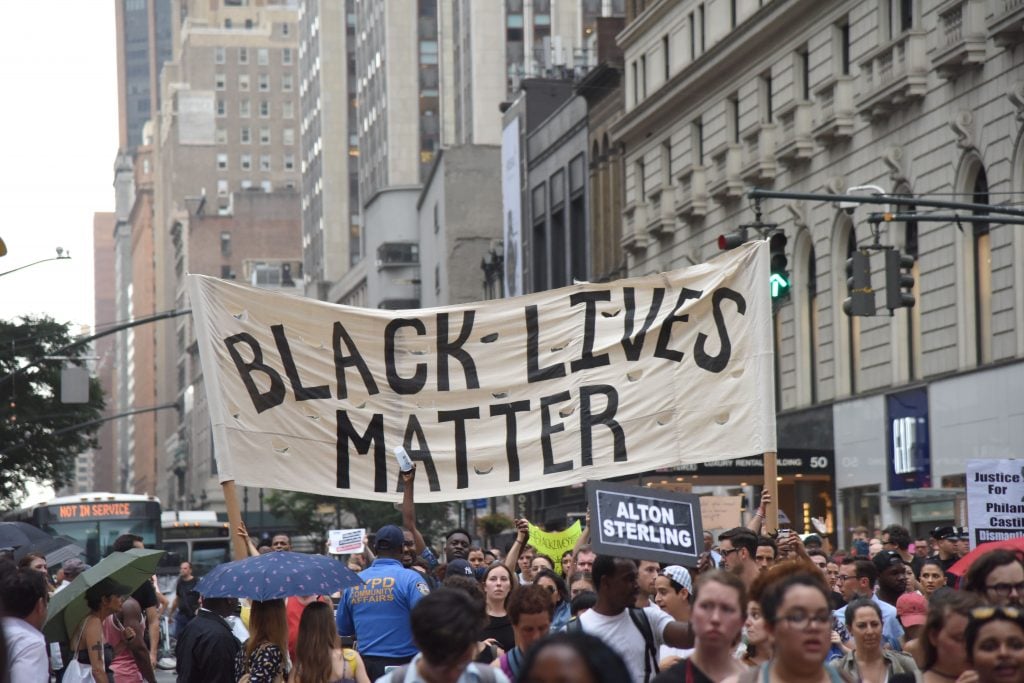Crimes Against Blacks, Women Still Underreported in Media
Whichever statistics one relies upon or report one consults, the difference in violence experienced by white women and women of color is dramatic, and much can be reported about the causes, societal implications and effective interventions.
February 21, 2020 at 11:07 AM
6 minute read
 White victims tend to get close attention while the murder of people of color is often callously left unexplored.
White victims tend to get close attention while the murder of people of color is often callously left unexplored.
A new study, Black Homicide Victimization in the United States: An Analysis of 2016 Homicide Data taps unpublished data from the FBI's Supplementary Homicide Report to rank states according to the number of black teens and adults murdered there. The data available from 2016 reveals a national crisis. According to the data, in 2016 there were 7,756 black homicide victims in the United States. The homicide rate among black victims in the United States was 20.44 per 100,000. For that year, the overall national homicide rate was 5.10 per 100,000. For whites, the national homicide rate was 2.96 per 100,000, or less than 15% of that for Blacks.
The homicide rate for black male victims was 37.12 per 100,000. In comparison, the overall rate for male homicide victims was 8.29 per 100,000. For white male homicide victims it was 4.39 per 100,000, or 12% of the rate for blacks.
The homicide rate for female black victims was 5.07 per 100,000. In comparison, the overall rate for female homicide victims was 1.97 per 100,000. For white female homicide victims it was 1.55 per 100,000.
According to a 2017 Centers for Disease Control and Prevention report, black and indigenous women are slain at significantly higher rates than women of other races. Black women are killed at a rate of 4.4 per 100,000 people, and indigenous women at a rate of 4.3 per 100,000; every other race has a homicide rate of between one and two per 100,000. Hispanic women who were killed, meanwhile, were the most likely to be killed in connection to partner violence (61 percent of all homicides of Hispanic women). While homicide is a leading cause of death for all women under 44, the CDC found non-Hispanic black women are "disproportionately affected" when compared to other racial groups in the United States. In fact, the homicide rate for black and Native American women was twice that of Asian, Hispanic and white women.
The CDC analyzed 18 years of data from 18 states compiled by the National Violent Death Reporting System between 2003 and 2014, and found at least 55.3 percent of female homicides were related to intimate partner violence, in which a victim was killed by her current or former partner or caught in the crossfire of an intimate partner homicide. The CDC report proposed targeted prevention programs for high-risk women and enhanced access to services to reduce female homicide rates. But that's easier said than done, due in part to the lack of trust in the system that minority women experience.
In a recent report, the Justice System Advocate for the Domestic Violence & Child Advocacy Center cautioned that African-American women are less likely to contact domestic violence service providers or call police when they're abused, thus increasing their risk of being killed, in part because they are often fearful of reinforcing racial stereotypes that the black community is violent.
Whichever statistics one relies upon or report one consults, the difference in violence experienced by white women and women of color is dramatic, and much can be reported about the causes, societal implications and effective interventions. But little has been written acknowledging the difference in news reporting. The disparity in treatment is palpable. This is not to suggest that the disappearance of any woman, especially a mother of five young children, should not receive attention, but stories about Jennifer Farber Dulos were non-stop all summer, and her case continues to receive a disproportionate amount of attention. Most of us remember the case of Natalie Ann Holloway, the American teen whose 2005 disappearance in the Caribbean became the nightly news subject of Nancy Grace, the subject of a made for TV movie and breathtaking headlines here and abroad.
Sadly, over the years there have been untold cases involving mothers of color who have gone missing or have been suspected homicide victims that prosecutors could tell you about. Equally overlooked are the cases of countless children of color being raised by grandmothers living below the poverty line because their mothers have similarly disappeared or been the subject of foul play. Just ask any social worker at the Connecticut Department of Children and Families how many such grandmothers are on his or her caseload. Is the disparate treatment because Ms. Dulos and Ms. Holloway are white, pretty, and rich? Are their lives more valuable or their stories more sympathetic? We do not suggest that their stories are not noteworthy, just that they are not any more noteworthy than any other tragic disappearance.
What is the role of the media in reporting these matters? Is it simply clickbait for revenue purposes? Or is there a broader principle at issue? The protections afforded the media by the First Amendment suggest that it plays a critical role as the Fourth Estate by reporting matters of public importance. The disparity in reporting on racial grounds indicates that the media is no longer prioritizing the latter function. We believe the media should consider whether it is fulfilling its role and if not, take steps to address it.
Rather than looking at cases through the lens of how salacious the details are, the media should be focusing on high risk factors and contributing root causes. According to the World Bank, a simple measure of inequality predicts about half of the variance in murder rates between American states and countries around the world. Rates of gun ownership (which rise when inequality does) and cultural traits like placing more emphasis on honor (which also is linked with inequality, especially when your social reputation in the community is all you have) are contributing factors.
The intent here is not to identify all such reasons but rather to suggest that we broaden our media focus to include a discussion of these issues in an effort to educate the public broadly and galvanize all of us to work together to develop strategies and interventions that can be used to reduce the likelihood of homicide victimization and offending where the risks are the greatest. Let's broaden our horizons; maybe we'll have fewer salacious stories to write about in the long run.
This content has been archived. It is available through our partners, LexisNexis® and Bloomberg Law.
To view this content, please continue to their sites.
Not a Lexis Subscriber?
Subscribe Now
Not a Bloomberg Law Subscriber?
Subscribe Now
NOT FOR REPRINT
© 2025 ALM Global, LLC, All Rights Reserved. Request academic re-use from www.copyright.com. All other uses, submit a request to [email protected]. For more information visit Asset & Logo Licensing.
You Might Like
View All
Coerced Confessions and the Burden of Proof Beyond Reasonable Doubt


35 Years After CT's Affordable Housing Act, Progress Remains a Struggle
4 minute readTrending Stories
- 1States Accuse Trump of Thwarting Court's Funding Restoration Order
- 2Microsoft Becomes Latest Tech Company to Face Claims of Stealing Marketing Commissions From Influencers
- 3Coral Gables Attorney Busted for Stalking Lawyer
- 4Trump's DOJ Delays Releasing Jan. 6 FBI Agents List Under Consent Order
- 5Securities Report Says That 2024 Settlements Passed a Total of $5.2B
Who Got The Work
J. Brugh Lower of Gibbons has entered an appearance for industrial equipment supplier Devco Corporation in a pending trademark infringement lawsuit. The suit, accusing the defendant of selling knock-off Graco products, was filed Dec. 18 in New Jersey District Court by Rivkin Radler on behalf of Graco Inc. and Graco Minnesota. The case, assigned to U.S. District Judge Zahid N. Quraishi, is 3:24-cv-11294, Graco Inc. et al v. Devco Corporation.
Who Got The Work
Rebecca Maller-Stein and Kent A. Yalowitz of Arnold & Porter Kaye Scholer have entered their appearances for Hanaco Venture Capital and its executives, Lior Prosor and David Frankel, in a pending securities lawsuit. The action, filed on Dec. 24 in New York Southern District Court by Zell, Aron & Co. on behalf of Goldeneye Advisors, accuses the defendants of negligently and fraudulently managing the plaintiff's $1 million investment. The case, assigned to U.S. District Judge Vernon S. Broderick, is 1:24-cv-09918, Goldeneye Advisors, LLC v. Hanaco Venture Capital, Ltd. et al.
Who Got The Work
Attorneys from A&O Shearman has stepped in as defense counsel for Toronto-Dominion Bank and other defendants in a pending securities class action. The suit, filed Dec. 11 in New York Southern District Court by Bleichmar Fonti & Auld, accuses the defendants of concealing the bank's 'pervasive' deficiencies in regards to its compliance with the Bank Secrecy Act and the quality of its anti-money laundering controls. The case, assigned to U.S. District Judge Arun Subramanian, is 1:24-cv-09445, Gonzalez v. The Toronto-Dominion Bank et al.
Who Got The Work
Crown Castle International, a Pennsylvania company providing shared communications infrastructure, has turned to Luke D. Wolf of Gordon Rees Scully Mansukhani to fend off a pending breach-of-contract lawsuit. The court action, filed Nov. 25 in Michigan Eastern District Court by Hooper Hathaway PC on behalf of The Town Residences LLC, accuses Crown Castle of failing to transfer approximately $30,000 in utility payments from T-Mobile in breach of a roof-top lease and assignment agreement. The case, assigned to U.S. District Judge Susan K. Declercq, is 2:24-cv-13131, The Town Residences LLC v. T-Mobile US, Inc. et al.
Who Got The Work
Wilfred P. Coronato and Daniel M. Schwartz of McCarter & English have stepped in as defense counsel to Electrolux Home Products Inc. in a pending product liability lawsuit. The court action, filed Nov. 26 in New York Eastern District Court by Poulos Lopiccolo PC and Nagel Rice LLP on behalf of David Stern, alleges that the defendant's refrigerators’ drawers and shelving repeatedly break and fall apart within months after purchase. The case, assigned to U.S. District Judge Joan M. Azrack, is 2:24-cv-08204, Stern v. Electrolux Home Products, Inc.
Featured Firms
Law Offices of Gary Martin Hays & Associates, P.C.
(470) 294-1674
Law Offices of Mark E. Salomone
(857) 444-6468
Smith & Hassler
(713) 739-1250











